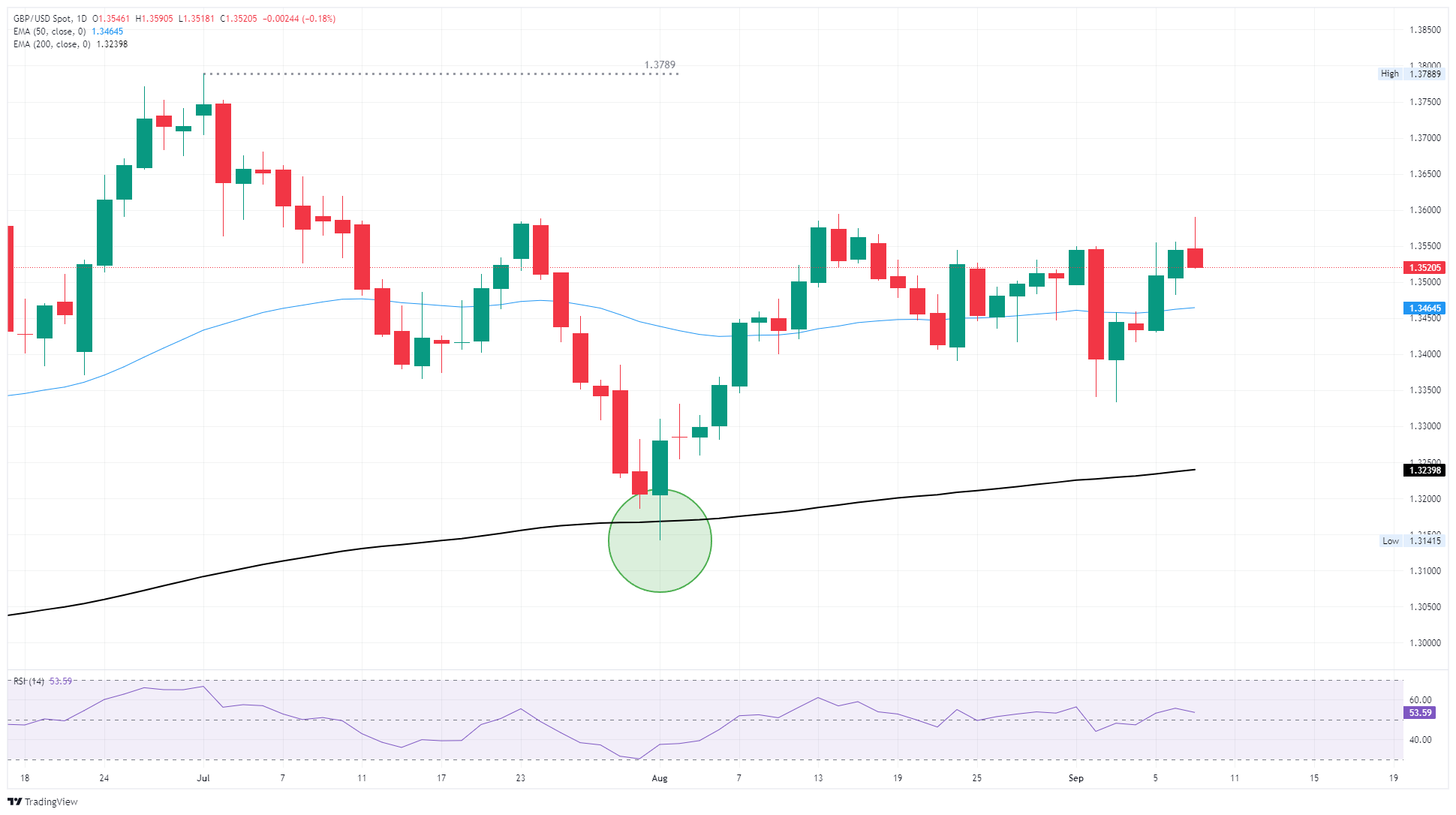GBP/USD reverses gains ahead of US inflation figures
- GBP/USD briefly tested a four-week high on Tuesday.
- Crumbling US jobs revisions bolstered the US Dollar as Fed rate cut bets rise.
- A last round of US inflation data is due before the Fed’s rate call next week.
GBP/USD briefly touched a four-week peak on Tuesday, testing chart territory north of 1.3550 before getting dragged back into the low side, snapping a two-day winstreak and putting Cable back on track for a decline to the 1.3500 handle.
The economic calendar remains functionally free of United Kingdom (UK) data this week, leaving US inflation figures in the driver’s seat as investors reel from a shocking decline in United States (US) labor market data that continues to get revised even lower.
Markets are growing increasingly concerned that the bottom could be falling out from beneath the US economy. The latest annual adjustment to Nonfarm Payrolls (NFP) showed that the US economy added nearly 900K fewer jobs than previously expected for the March 2024 to March 2025 annual period. Further downside revisions to 2025 employment creation should be expected by data watchers as the current revision window doesn’t include any of the fallout of the post-tariff economy.
Withering US jobs bolster Fed rate cut bets
The NFP is an aggregate survey of around 120K private businesses within the US; the response rate frequently changes, and any businesses that cease operations within the response window are simply marked as non-respondents.
The Bureau of Labor Statistics (BLS) uses the Quarterly Census of Employment and Wages (QCEW) to do a large-scale adjustment to NFP data once per year. This data represents 95% of the business operators within the US and is a more accurate measure of labor, as it includes businesses that have either ceased operations or gone out of business. Even now, the “final” benchmark revision for the current review period isn’t expected until next February.
According to the CME’s FedWatch Tool, rate markets have assumed a 25 bps interest rate cut on September 17 is now a foregone conclusion. Some particularly cut-happy rate traders are also pricing in over 17% odds that the Fed will get bullied, either by data or political pressure, into delivering a 50 bps rate cut next week.
The latest batch of US Consumer Price Index (CPI) inflation, due on Thursday, is expected to show that inflationary price pressure is still coasting well above the Fed’s 2% annual target. This makes it difficult for the Fed to deliver interest rate cuts at too fast of a pitch, regardless of how far policy rates may or may not be above r-star, or the natural rate of interest.
GBP/USD daily chart

Pound Sterling FAQs
The Pound Sterling (GBP) is the oldest currency in the world (886 AD) and the official currency of the United Kingdom. It is the fourth most traded unit for foreign exchange (FX) in the world, accounting for 12% of all transactions, averaging $630 billion a day, according to 2022 data. Its key trading pairs are GBP/USD, also known as ‘Cable’, which accounts for 11% of FX, GBP/JPY, or the ‘Dragon’ as it is known by traders (3%), and EUR/GBP (2%). The Pound Sterling is issued by the Bank of England (BoE).
The single most important factor influencing the value of the Pound Sterling is monetary policy decided by the Bank of England. The BoE bases its decisions on whether it has achieved its primary goal of “price stability” – a steady inflation rate of around 2%. Its primary tool for achieving this is the adjustment of interest rates. When inflation is too high, the BoE will try to rein it in by raising interest rates, making it more expensive for people and businesses to access credit. This is generally positive for GBP, as higher interest rates make the UK a more attractive place for global investors to park their money. When inflation falls too low it is a sign economic growth is slowing. In this scenario, the BoE will consider lowering interest rates to cheapen credit so businesses will borrow more to invest in growth-generating projects.
Data releases gauge the health of the economy and can impact the value of the Pound Sterling. Indicators such as GDP, Manufacturing and Services PMIs, and employment can all influence the direction of the GBP. A strong economy is good for Sterling. Not only does it attract more foreign investment but it may encourage the BoE to put up interest rates, which will directly strengthen GBP. Otherwise, if economic data is weak, the Pound Sterling is likely to fall.
Another significant data release for the Pound Sterling is the Trade Balance. This indicator measures the difference between what a country earns from its exports and what it spends on imports over a given period. If a country produces highly sought-after exports, its currency will benefit purely from the extra demand created from foreign buyers seeking to purchase these goods. Therefore, a positive net Trade Balance strengthens a currency and vice versa for a negative balance.

